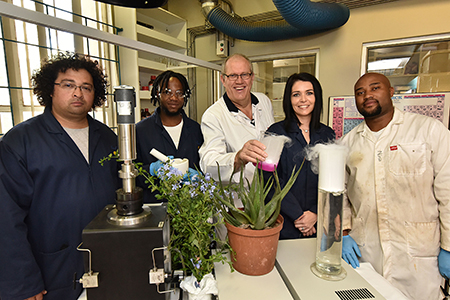
The Inorganic Group in the Department of Chemistry
at the UFS is systematically researching the utilisation
of carbon dioxide. From the left, are, Dr Ebrahiem Botha,
Postdoctoral Fellow; Mahlomolo Khasemene, MSc student;
Prof André Roodt; Dr Marietjie Schutte-Smith, Senior Lecturer;
and Mokete Motente, MSc student.
Photo: Charl Devenish
Several industries in South Africa are currently producing hundreds of thousands of tons of carbon dioxide a year, which are released directly into the air. A typical family sedan doing around 10 000 km per year, is annually releasing more than one ton of carbon dioxide into the atmosphere.
The Inorganic Chemistry Research Group in the Department of Chemistry at the University of the Free State (UFS), in collaboration with the University of Zurich in Switzerland, has focused in recent years on using carbon dioxide – which is regarded as a harmful and global warming gas – in a meaningful way.
According to Prof André Roodt, Head of Inorganic Chemistry at the UFS, the Department of Chemistry has for the past five decades been researching natural products that could be extracted from plants. These products are manufactured by plants through photosynthesis, in other words the utilisation of sunlight and carbon dioxide, nitrogen, and other nutrients from the soil.
Caffeine and chlorophyll
“The Inorganic group is systematically researching the utilisation of carbon dioxide. Carbon dioxide is absorbed by plants through chlorophyll and used to make interesting and valuable compounds and sugars, which in turn could be used for the production of important new medicines,” says Prof Roodt.
Caffeine, a major energy enhancer, is also manufactured through photosynthesis in plants. It is commonly found in tea and coffee, but also (artificially added) in energy drinks. Because caffeine is a stimulant of the central nervous system and reduces fatigue and drowsiness, some people prefer decaffeinated coffee when enjoying this hot drink late at night.
Removing caffeine from coffee could be expensive and time-consuming, but also environmentally unfriendly, because it involves the use of harmful and flammable liquids. Some of the Inorganic Group’s research focus areas include the use of carbon dioxide for the extraction of compounds, such as caffeine from plants.
“Therefore, the research could lead to the availability of more decaffeinated coffee products. Although decaffeinated coffee is currently aromatic, we want to investigate further to ensure better quality flavours,” says Prof Roodt.
Another research aspect the team is focusing on is the use of carbon dioxide to extract chlorophyll from plants which have medicinal properties themselves. Chemical suppliers sell chlorophyll at R3 000 a gram. “In the process of investigating chlorophyll, our group discovered simpler techniques to comfortably extract larger quantities from green vegetables and other plants,” says Prof Roodt.
Medicines
In addition, the Inorganic Research Group is also looking to use carbon dioxide as a building block for more valuable compounds. Some of these compounds will be used in the Inorganic Group’s research focus on radiopharmaceutical products for the identification and possibly even the treatment of diseases such as certain cancers, tuberculosis, and malaria.